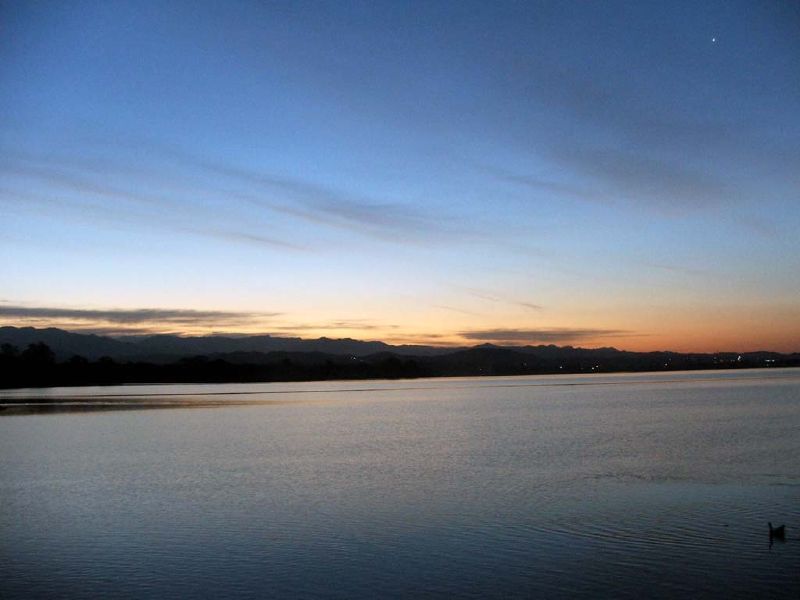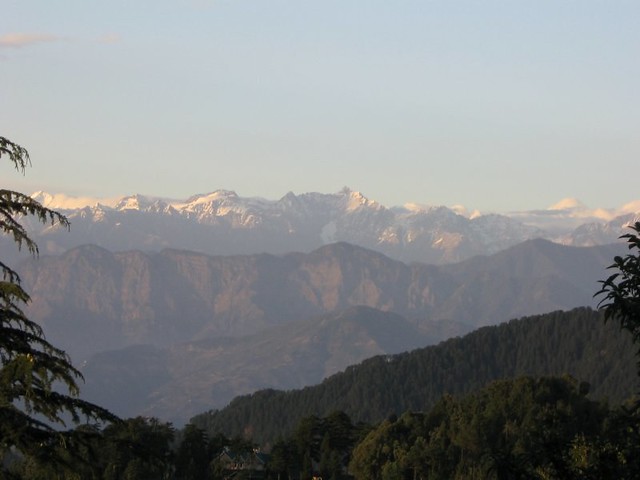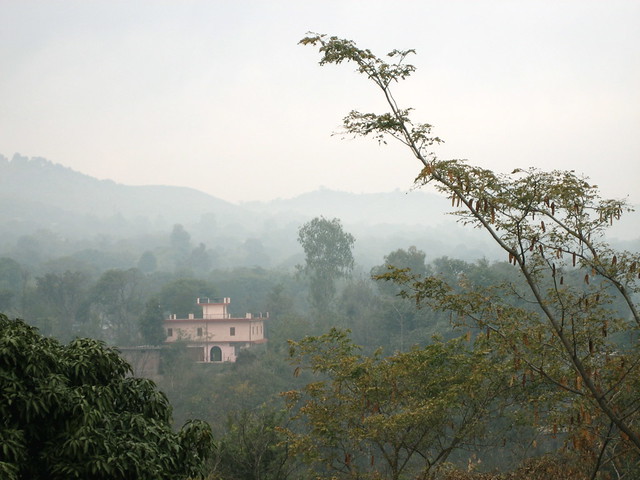A hill journey, like wine, is to be savoured in small measures. It needs the kind of indulgence reserved for a tasting session. You ought to pause and sip in the vistas at leisure and let new vocabulary take birth to describe the range of flavours, aromas and personalities. On the opening day of our road trip, that is precisely what was not on the agenda for us. We gulped our way to the destination. The Chandigarh-to-Chamba-and back drive was spread over nine days, three states and around 930 km.

Chandigarh Lake (Photo by Wikimedia)
The sun shone in all its brilliance as we crossed Chandigarh and Panchkula in neighbouring Haryana, skipping the office hour rush. The Innova was zipping on NH22 before long and we were soon driving past the terraced Mughal Gardens at Pinjore. At the town’s bus stand intersection, directions were sought for Bilaspur and bystanders warned us about the appalling condition of NH21A. We didn’t realise how appalling it was till we reached a little ahead of Nalagarh, where we stopped for a scrumptious breakfast at the Heritage Fort Resort. There was a diversion through an undulating, unmetalled strip and then another one where we had to wade through water as the bridge had collapsed. Our driver, though named Sher Singh, was petrified about taking risks. He hummed and hawed before his confidence was restored and he drove into the flowing stream with the flamboyance of a veteran rallyist. Our experience turned out to be a prelude.
Nalagarh-Swarghat is a winding segment perpetually under construction. The highway is a combination of potholes and crushed boulders as well as intermittent kuccha tracks that raise billows of dust, reducing visibility to zero. It took us one-and-a-half hours to do the 20-odd km and our vitals had quite a rearrangement by the time we hit NH21 at Swarghat. It was noon then, usually a chosen time in the hills for an outburst from the heavens. That day was no different and it poured as though there was no tomorrow. The lush green hills, the result of an over-abundant monsoon, revelled in the shower. As the winds howled, trees began a dance as if they had been enchanted. In the hills, rain acquires a timbre that’s quite mesmerising. These were moments to pause and soak it all in. As we reached Bilaspur, the odometer showed we had travelled a mere 126.6 km; according to the watch, we had been on the road for over 5 hrs. We were hoping to stop at the Gobind Sagar Lake en route but it was increasingly turning out to be a race against time.

Nalagarh (Photo by Passetti)
At Mandi, we crossed over on to NH20 and here began our ascent through pleasurable countryside. Jogindernagar was the pick amongst the spots we passed, with terraced paddy fields and panoramic views. Heavy rain made visibility poor and just as it thinned, fog enveloped the route, reducing us to a crawl. When we finally reached our first stopover, the Norbulingka Institute at Sidhpur, 17 km short of McLeodganj, we had been on the road for an almost-continuous 14 hrs.
McLeodganj, the seat of His Holiness the 14th Dalai Lama, is delightfully nestled in the conifer lap of Upper Dharamsala, with the Dhauladhar ranges forming an imposing backdrop. We spent two days roaming its bustling, multi-ethnic but heavily Tibetan streets, and tucking into momos and thukpa.

Dalhousie (Photo by Srini G)
Pretty views of the Beas
The drive to Dalhousie from Dharamsala was a series of sharp turns, blind curves and hairpin bends that snaked over bridges, along sprightly springs, gushing rivulets, seasonal waterfalls and terraced fields dotted with traditional mud-slate roofed homes. Every bend was a painter’s canvas, with pretty views of River Beas appearing quite often and the rain adding its own dimension off and on. The bends around Kakroti and Kakiara hamlets gave a bird’s eye view of the landscape. A terrific chai halt, just as we had exited Dharamsala, was Dhouladhar Bhojanalya, perched at the edge of the hill and by a stream. A little short of Sihunta town, Dhakauli, a two-home hamlet by a brook, had caught my fancy and I went peering inside typical Chamba-style courtyards, to be welcomed by the families of a certain Maanbakhsh and Noordin residing there. Initial staccato responses became merry conversation, where in a reversal of events I became the interviewed.
As I was leaving, Maanbakhsh summoned his granddaughter. She went running to the fields and came back with an armload of cucumbers, shyly offering them to me even as the whole family looked on. Overwhelmed, I picked up a few. It was the best gift I’d received in a long while.
As we reached Dalhousie (6,678 ft), a most spectacular sight unfolded before us. The fog cover lifted and the evening sunlight cast a mellow glow on the surrounding mountain ranges and the valley below, and the majestic Pir Panjal came into view. I forgot all about checking in, took a garden chair and didn’t move till the town wore its evening cloak and the air became frosty. Every season is special here. During the stay, I experienced its pleasant late summer. In deep winter it would be another realm draped in regal white. The hills around colonial Dalhousie are a hiker’s paradise. One of the level treks is to Kalatop Wildlife Sanctuary, 81/2 km from Gandhi Chowk, the town’s centre. Home to the Himalayan black bear, we ventured there on our way to Chamba and took a stroll among its deodars but didn’t spot any wildlife. The cackling of a lone treepie was all that entertained us. It took us less than an hour to reach typically touristy Khajjiar (6,400 ft) on a smooth tarmac. We munched on juicy cucumbers and radish as we observed the world busying itself in various activities – zorbing, parasailing and horse riding – on a pretty glade fringed with deodars standing as sentinels. Within half an hour of us being there, rain, our trusted mate, reined us inside the Innova.

Paragliding in Dalhousie (Photo by rajkumar1220)
In a jiffy, vacationer action disappeared and all that remained on the squinting green glade were its quintessential occupants: herds of sheep, Jersey cows, a few ponies and horses. At the spot we were parked, a local musician began belting out stirring Chambiyali folk songs on his mandolin. In that one instant, touristy Khajjiar turned into a pasture of bliss.
Destination Chamba
The onward journey to Chamba was also a stall-and-move affair. We stopped at a viewpoint near Lord Shiva’s statue from where on a clear day Mount Kailash can be seen. We unsuccessfully waited for the cloud cover to lift and then made our way downhill through landslide-prone stretches and scenic green hills speckled with houses. River Ravi meandered into the landscape a few kilometres short of our destination and just as the odometer showed us a perfect reading of 500 km, we arrived at Chamba’s hub, Chaugan. As it turned out, Chamba (3,000 ft) had been invaded by pilgrims returning from the Manimahesh Yatra. Chaugan was their halting ground and tridents of all shapes and sizes, festooned with holy red scarves, decked the green lawn. In one corner of the ground, a national-level tourney of Thanga-ta or Manipuri martial arts, was in progress. I was part of its spectator gallery for a while before I scampered off to see the palm-sized town established a thousand years ago. Chamba rulers had been patrons of the arts and as I walked its bylanes, I discovered the fact that the town was a cultural treasure trove; there were metal sculptures, silver crafts, miniature paintings and Chamba rumaals (square cloth adorned with Chamba’s famous double satin stitch embroidery, called dorukha or two-sided, as both sides are usable). This was quite apart from the architectural beauty and fine workmanship found on Chamba’s old buildings, in particular the green-roofed Akhand Chandi Palace – a girl’s college now – that overlooks the Chaugan.

Chamba Valley (Photo by Voobie)
Chamba was also the only place where we relished delicious pahari food, in particular the rajma madra (kidney beans cooked in equal amounts of ghee and curd) and the kadi. The taste of Chamba continued to linger for days after the journey. On our way back to Kangra Valley, we took SH43, which traversed through Jot – the highest point en route (8,398.95 ft) – and Chowari. It was a clear day and as we approached Jot what greeted us was a panoramic snow-capped mountain range. As I trained the camera lens on the ranges, a shepherd moving his herd down the hills pointed out a slender peak. “You must click that,” he said. “You are blessed to have spotted Mount Kailash.” Hail Shiva! He had finally unveiled his abode for us.
Past Chowari and Lahru, the drive became flatter, and Nurpur onwards, NH20 took us through urban environs to our next stopover: the tea gardens of Palampur (4,000 ft). Our cottage was a perfect getaway from civilisation despite being barely a few minutes from it.
Early next morning, we drove around the tea estates and the town’s central market. The Dhauladhars look superlative here lending a distinctive charm to sylvan Palampur. Another element that adds to the town’s attraction is the sound of water from its network of brooks, from which the town gets its name, the local word for water being ‘pulam’. Our final halt, Pragpur (1,919 ft), was a heritage village, 88 km and 2 hrs away. We drove past densely forested low-lying hills. Denudation of the hills alongside the highway have made them landslide prone with seasonal rivulets adding to the damage of the tarmac, which remains patchy right up to Pragpur. After a splendid night at a heritage country manor here, where we let ourselves be pampered by exceptional service, it was time to hit the road back home.

Pragpur (Photo by Dave Kleinschmidt)
At Nangal, just as we entered Punjab for the first time on this trip, we skipped the highway route via Kiratpur and instead took a diversion through Nurpur Bedi to reach Ropar (NH21) and move on to Chandigarh. The Kikar Lodge (Mob: 09478964971; Tariff: Rs 14,000-18,000 for 3D/ 2N) nearby makes for a pleasant night halt. The country track detour was typical of verdant, pastoral Punjab and driving on an avenue canopied by kikar trees provided a splendid finale to our journey.
On the road
It’s best to start around 7 AM from Chandigarh. In summers, 5 AM will be suitable if you want to drive right up to Dharamsala via Mandi and stop en route. From Chandigarh to Pinjore, you’ve to take NH22; from Pinjore to Swarghat, you have two options – NH21A, a shorter but very bad road and therefore avoidable but it goes via Nalagarh, and the longer but decent NH21.

Chandigarh highway (Photo by Siddhartha206)
On the latter route, you drive through Kurali, Ropar (or Rupnagar) and Kiratpur. From Swarghat, you are onto NH21, which takes you from Bilaspur to Mandi and NH20 from Mandi to Malan via Palampur. The rest of the journey till Dharamsala and onwards to Rait is on district roads. The drive from Rait to Draman is on NH20, from where you have to take state highways (43 and 28) to Banikhet via Tunnuhatti. The drive till Dalhousie and Khajjiar is on district roads. Chamba and Nurpur, on the way back to Palampur, are accessed via state highways (33, 43 and 28). From Nurpur, take NH20 to Palampur; then back to Mator Chowk to take NH88 till Jwalamukhi Junction, from where you get onto SH23 till Nehran Pukhar.
A country road (now a state highway) connects Nehran Pukhar to Pragpur. To move on to Chandigarh, head towards Kaloha, 6 km away on NH70, and drive on to Amb (though the route this writer took was Pragpur-Nehran Pukhar- Mubarakpur-Amb); and then take state highways (25 and 22) via Una to Nangal. Though a state highway connects Nangal to Kiratpur, we took a country road instead to come out on NH21 after Ropar as the Kiratpur-Ropar stretch is all about bottlenecks and heavy traffic. NH21 takes you to Chandigarh via Kurali and Kharar. From Mandi onwards, NH20 via Jogindernagar to Dharamsala can get deserted as soon as it gets dark. Except in and around towns en route, no mechanics or puncture repair shops are open at a late hour. If driving in winters, it’ll be prudent to begin early and reach the destination when it’s well lit. As of now, NH21A is single-lane and the road conditions are rather poor. This circuitous route remains a favourite with rallyists who get an adrenaline rush doing the rickety bends.
About the author:
Brinda Suri has worked in diverse editorial capacities in the newspaper industry, where she would adjust the happenings of the world in seven-column grids. Now she trots at will and shares reports on the wanderings from the world she used to edit.



